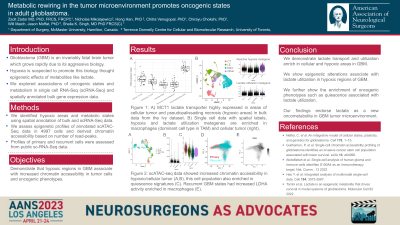Metabolic rewiring in the tumor microenvironment promotes oncogenic states in adult glioblastoma.
Metabolic Rewiring in the Tumor Microenvironment Promotes Oncogenic States in Adult Glioblastoma
Friday, April 21, 2023


Zsolt Zador, MD, PhD, FRCS, FRCSC
Staff Neurosurgeon and Clinical Scolar
McMaster University
Oakville, Ontario, Canada
ePoster Presenter(s)
Introduction: Glioblastoma (GBM) is an invariably fatal brain tumor which grows rapidly due to its aggressive biology. Increasing metabolic demand translates to hypoxia in the tumor microenvironment. These hypoxic regions reprogram tumor biology and in-vitro studies suggested metabolites such as lactate promote epigenetic changes which then promote oncogenesis. We therefore hypothesized that hypoxic regions in GBM associate with increased chromatin accessibility in tumor cells promoting oncogenic phenotypes.
Methods: Using verified gene expression signatures, we identified hypoxic areas and metabolic states in public datasets with spatial annotation. Using meta-gene signature enrichment scores we annotated single cell RNA-Seq (scRNA-seq) from 16201 cells with spatial labels and identities including canonical GBM programs. To assess epigenetic profiles we transferred spatial labels from scRNA-Seq data to gene activation matrix of single cell genomic access (scATAC-Seq) profiles in 4997 cells and derived chromatin accessibility based on number of read-peaks.
Results: The spatial distribution of hypoxic signatures and markers of lactate utilization enriched in areas of pseudopalisading cells around necrosis (PAN) and cellular tumor (CT) while leading edge (LE) showed lower signal. ScRNA-seq showed enrichment of macrophages and mesenchymal tumor cells with necrotic spatial labels while leading edge enriched in neuronal progenitor identifies and cellular tumor was abundant in astrocyte-like identities. Label transfer to scATAC-seq data showed significantly more abundant accessible chromatin regions in cells labeled as cellular tumor. Epigenetic profile of cellular tumors further enriched in oncogenic signatures such as quiescence. We finally investigated recurrent GBM states and found LDHA activity enriched in macrophages on recurrence but remained unchanged in tumor cells.
Conclusion : We analyzed single cell multi-omics datasets with spatial labels. We demonstrate epigenetic alterations associate with lactate utilization in hypoxic regions of GBM. We further show the enrichment of oncogenic phenotypes associated with lactate utilization endorsing lactate as a new oncometabolite in the recurrent GBM tumor immune microenvironment.
Methods: Using verified gene expression signatures, we identified hypoxic areas and metabolic states in public datasets with spatial annotation. Using meta-gene signature enrichment scores we annotated single cell RNA-Seq (scRNA-seq) from 16201 cells with spatial labels and identities including canonical GBM programs. To assess epigenetic profiles we transferred spatial labels from scRNA-Seq data to gene activation matrix of single cell genomic access (scATAC-Seq) profiles in 4997 cells and derived chromatin accessibility based on number of read-peaks.
Results: The spatial distribution of hypoxic signatures and markers of lactate utilization enriched in areas of pseudopalisading cells around necrosis (PAN) and cellular tumor (CT) while leading edge (LE) showed lower signal. ScRNA-seq showed enrichment of macrophages and mesenchymal tumor cells with necrotic spatial labels while leading edge enriched in neuronal progenitor identifies and cellular tumor was abundant in astrocyte-like identities. Label transfer to scATAC-seq data showed significantly more abundant accessible chromatin regions in cells labeled as cellular tumor. Epigenetic profile of cellular tumors further enriched in oncogenic signatures such as quiescence. We finally investigated recurrent GBM states and found LDHA activity enriched in macrophages on recurrence but remained unchanged in tumor cells.
Conclusion : We analyzed single cell multi-omics datasets with spatial labels. We demonstrate epigenetic alterations associate with lactate utilization in hypoxic regions of GBM. We further show the enrichment of oncogenic phenotypes associated with lactate utilization endorsing lactate as a new oncometabolite in the recurrent GBM tumor immune microenvironment.
